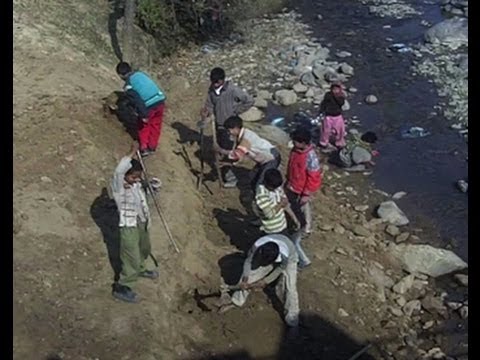By Josepha Laroche
Passage au crible n°6
 Source: YouTube
Source: YouTube
The international Convention on the Rights of the Child was adopted on November 20, 1989 and has since been ratified by all the countries of the world excepting the United States and Somalia. This text recognizes “the right of the child to be protected from economic exploitation and from performing any work that is likely to be hazardous or to interfere with the child’s education, or to be harmful to the child’s health or physical, mental, spiritual, moral or social development” (article 32). Nevertheless, in 2009, a billion children have their most elementary rights trampled upon on a daily basis, while more than a million are still victims of the slave trade. Amongst the many forms of violence against children, we shall examine those concerning the labour they are forced to undertake, mainly in the developing countries. In its 2004 report, the ILO (International Labour Organization) estimated that worldwide there are currently more than 360 million children aged 5 to 17 who work, that is one in four of the global child population.
> Historical background
> Theoretical framework
> Analysis
> References
This is not a new phenomenon linked to the process of globalization. In the Occident, children worked from the Middle Ages, thus participating in the domestic economy. Outside the family circle, they were subjected to rental contracts, providing docile, inexpensive even free labour. Later, the Industrial Revolution marked a historical turning point since they worked in the mines, mills, metal works and large factories. But the priority was always the same – adjusting and reducing costs while disposing of particularly vulnerable and submissive workers. It was only at the end of the 19th century – notably thanks to compulsory schooling – that developed countries moved towards regulation and later abolition of child labour.
On a global level, the ILO – with its 181 member states – has set the minimum age for employment at 15. In 1976, this institution adopted a treaty specifically dealing with child labour: convention 138. This convention bans work before the end of compulsory schooling in each country and in all cases before the age of 15. Above all it totally prohibits all activity which “is likely to jeopardise the health, safety or morals of young persons” aged less than 18. However, this text has only been ratified by 150 countries, even if, in 1992, the ILO initiated an international program for the elimination of child labour (IPEC) funded by certain developed countries.
Two interdependent principles are at work.
1. The intensification of the North-South divide. This exploitation is due to socio-economic destitution and the deficiency of the educational systems existing in the countries of the South. The industrialized countries often accuse developing countries of social dumping. On the other hand, the developing countries consider that the imposition of Occidental norms – such as the banning of child labour – represents a concealed form of protectionism the only aim of which is to prevent them from being competitive in global marketplaces; Occidental manufacturers thus being indirectly protected by what is denounced as the ideology of human rights. To be specific, the developing countries stigmatize this position which they define as an unfair attack, destined to make them lose a comparative advantage.
2. The global mobilization of non-state actors. Inter-state organizations (the UNO itself or certain of its specialized institutions such as the ILO and UNICEF), NGOs and the networks of citizen-consumers participate – through their incessant interventions – In the modification of state policies and the strategies of transnational firms concerning this issue.
The 1980s were marked by an awakening of public awareness of child labour and its exploitation. Since then, networks made up of thousands of humanitarian NGOs, unions and consumer organizations have been mobilized and committed to actions in the field. For its part, UNICEF supports the most innovative actions such as those in the Philippines, Cambodia or Columbia. Other bodies have launched awareness campaigns targeting international organizations – the IMF, the World Bank, and the ILO – and governments, while, at the same time, putting constant pressure on economic decision-makers.
Good conduct codes have thus been established in the wake of public campaigns at the initiative of OXFAM and the European Fair Trade Association, for instance. Numerous companies have thus come to understand the necessity – and above all the economic impact in terms of image and commercial policy – of adopting charters through which they have committed to respecting the rights of the child in their production process and accepted the principle of independent monitoring. For the moment, taking all categories into consideration, there are several hundred such agreements, of which half explicitly mention child labour. However, adoption of a charter is no guarantee of effectiveness: it may merely be an instance of show-casing. Nevertheless, economic operators can no longer ignore that 250 million children currently work in inhumane conditions, particularly for subcontractors. In particular, this sheds light on the true conditions of production which were concealed until now. This brings consumers to increasingly question the reasons explaining the abnormally low prices of certain manufactured goods coming from the developing countries.
For these reasons, certain consumers have implemented a buying ethic and created alternative circuits of ethically correct manufacture and consumption which correspond to conditions such as the respecting of human rights and, a fortiori, the rights of the child. This Fair Trade aims to support the development of the countries of the South, particularly through the implementation of social certifications, as an ethical mark on the product label, such as Ringmark or Step, which was created in 1995 by Caritas Swissair.
As for boycott campaigns, they underline the debate which exists between abolitionists and non abolitionists. With the support of consumer NGOs, such as the National Comsumers League or the Child Labor Coalition network, they have lead to certain firms such as Nike, Gap and Disney undergoing international scrutiny. Undeniably, this strategy has positive effects. However, it can also lead to perverse effects – unemployment, prostitution – and lead to merely displacing the problem; the children moving to other, hidden and worse employers. These mobilizations remain a double-edged weapon. Admittedly, they fire a warning shot and often modify the production strategy of transnational firms, which are very sensitive to the state of public opinion and attentive to the voice of consumers. Nevertheless, they cannot, in themselves, settle the inequalities in development and the social discrepancies which exist within the developing countries themselves.
Fombrun Charles, Reputation: Realizing Value from the Corporate Image, Cambridge, Harvard University Press, 1996.
Hirschman Albert, L’Économie comme science morale et politique, translation, Paris, Seuil, 1974.
Landrai Ndembi Denise, Le Travail des enfants en Afrique subsaharienne, Paris, L’Harmattan, 2006.
Manier Bénédicte, Le Travail des enfants, Nouv. Éd., Paris, La Découverte, 2003. Coll. Repères (265).
Winston Morton, “NGO Strategies for Promoting Social Responsibility”, Ethics and International Affairs, 16 (1), 2002, pp. 71-88.




